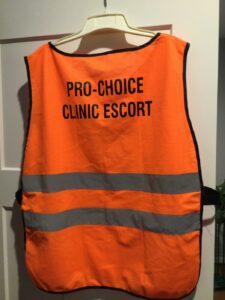Countering anti-abortion protests with a helping hand
Published in Ellemeno, Oct. 14, 2023 (https://medium.com/ellemeno/the-quiet-methods-of-abortion-clinic-escorts-1a6a1cf4a668)

The political signs for next year’s presidential and congressional elections point to abortion being a trigger issue for voters — again. Both anti-abortion and pro-choice people will be campaigning heatedly. Both sides will angle for the high ground, arguing on the general points of morality, fairness, and expediency.
I don’t want to reargue issues that have been debated for years because both sides have made their arguments and essentially convinced no one from the opposite side. Abortion is and will remain a polarizing issue.
In any polarized issue truth is whatever you declare it to be. It becomes a hostage to belief. In abortion the positions propounded by either side rest on conflicting beliefs. The anti-abortion argument has it that the entity a pregnant woman carries is a baby, unborn, yes, but a real baby. The pro-choice argument considers the entity to be a fetus. It becomes a baby at birth.
The one side believes that legal rights extend to this entity, the other denies the entity possesses those rights. The one side believes that a pregnant woman is required morally and legally to take the entity to term, the other that she can choose to take it to term or not.
By the way, I apologize to both sides for using the word ‘entity’ to label the baby/fetus. It’s not a pretty word, but it’s neutral.
These conflicting beliefs in essence pit religious arguments against medical arguments and they touch on issues that have no ready answers. They concern subjects such as when life begins, the meaning of human life, and society’s responsibility toward preserving life. More immediately, since there are two entities involved in a pregnancy, the arguments also debate who has the higher priority, especially if the survivability of one or the other is in question.
All of these arguments pro and con have been airing for decades, even centuries. One position or another can predominate in various cultures at various times. Abortion has been practiced probably throughout all of human history. To anti-abortion proponents, this history is dismissed as irrelevant to today. We’re better people than were our ancestors, they say. To pro-choice proponents, it was relevant then and remains so now.
In today’s world it seems foolhardy to believe that there will ever be agreement on eliminating abortion, but just as foolhardy to think that it ever will be eliminated, however stigmatized or criminalized it may be. You don’t achieve agreement when the premises are based on strongly-held beliefs that are diametrically opposed.
The sides are have tilted at one another from when the Supreme Court recognized a Constitutional right to abortion in 1973 to when it rescinded that right in 2022 and left it to state constitutions and legislatures to determine whether a woman can keep that right.
The media in those fifty years has been mostly fair in presenting the arguments of both sides, though there is a perceived bias by pro-life people that the media favors the pro-choice arguments. If that’s true, it may be a reflection of the majority public favoring women’s reproductive rights.
Still it’s not hard to find reporting detailing the pro-life positions and pro-life tactics expressed through prayer, leafleting, letter writing, lobbying, protests, and, in their most violent expression, abortion clinic arson, bombings, and the murder of abortion providers.
The news has been less diligent overall in advancing the arguments of pro-choice people, maybe because for those fifty years pro-choice was the law of the land. Now that they don’t have that right or a deeply eroded right in more than half of the states, including my own state of West Virginia, there’s been more coverage of the arguments and tactics of the pro-choice side.
Following the Supreme Court’s backtracking on the constitutionality of abortion and the West Virginia’s legislature essentially outlawing abortion, a small group of women in the Eastern Panhandle of West Virginia organized a counter effort. They decided to cross the state line into Maryland and volunteer to be clinic escorts at the only abortion clinic in the city of Hagerstown. Hagerstown is about 18 miles from the nearest West Virginia border crossing, a vehicular and foot bridge over the Potomac River at Shepherdstown, WV.
The Panhandle sticks out like a thumb following the hump of the Potomac River as it changes from a northwest to a southwest heading where Pennsylvania to the north, Maryland to the east, and Virginia to the south come together. Of those three states, Maryland has the most liberal abortion legislation, just that an abortion is proscribed when the fetus is viable outside the uterus. Pennsylvania and Virginia both limit abortion to the first 26 weeks of pregnancy. In West Virginia abortion at any stage of pregnancy is illegal.
The women in question — there are eight of them, mostly older than those they escort— volunteered and trained to be clinic escorts at the Hagerstown abortion clinic, the Potomac Family Planning Center.
I didn’t know anything about what clinic escorts do or why they do it, but because one of those eight women is a friend of mine, I inquired. The only thing I did know beforehand was that the clinic is regularly patrolled by anti-abortion protestors, like probably most abortion clinics in the country.
I talked with two of the local West Virginia women about why they participate and what their participation entails. I also spoke with one of the rare men who serve as escorts. He lives in Hagerstown.
Because of persistent harassment and threats of violence against escorts, all of them asked to have their names withheld. I’ll call them Carrie, Regina, and Joseph. As a matter of policy, escorts do not reveal their names to the people they call their clients. These are the women seeking abortions at the clinic. Neither do they address fellow escorts by name.

The duty of an escort is simply to accompany a client from her car to the front door of the clinic and to non-aggressively shield her from the group of protesters that are always there. By the FACE law, passed during the first Clinton administration, protesters cannot physically obstruct a clinic entrance or physically prevent a person from entering the clinic. But they can talk to both the clients and the escorts. That is their first amendment right.
In Hagerstown, immediately adjacent to the clinic, there is another facility, the Hagerstown Area Pregnancy Clinic (HPAC), an organization dedicated to preventing abortions, one of the so-called “pregnancy crisis centers”. Instead of abortion services, it provides information about alternatives to abortion accompanied often by the “evidence” of religious strictures against abortion. Both organizations do provide pregnancy testing.
Anti-abortion protesters will try to divert clients to HAPC. If a woman indicates that she has an appointment with Potomac Family Planning, the escort will navigate her to the right entrance.
Clinic escorts typically have only brief contact with a client. They will ask someone at her car if she has a clinic appointment and if she would like to be escorted. If so, the escort guides the client to the clinic door, buffering her from the protesters and sometimes shielding her face.
The comments from the protesters can be unnerving and upsetting. It’s not unusual for protesters to accuse the client of murder and condemn her and the escort to hell. The presence of the escort can be reassuring and can distract the client from the verbal attacks, but it comes at some personal cost. Regina said, “I don’t schedule anything else the day I volunteer. I need to decompress.”
Once at the clinic entrance, the escort opens the door into the waiting room and then closes the door behind the client after she enters. The escort does not go in, but stands outside ready to meet the next client or to accompany women exiting the clinic back to their cars.
The first rule of escorting is not ever to engage with the protesters, no matter how much they taunt. The reason for this, as Joseph explained, is not to add more emotional distress to the client. The escort’s behavior should be comforting and focused only on the client. It should not contribute to an already threatening atmosphere. As Joseph said, “It’s not okay for a person to be attacked. You don’t treat people that way. Your beliefs don’t allow you to be oppressive.”
The second rule of escorting is not to question the client about her clinic appointment. The Potomac Family Planning Center isn’t just about abortion. It provides other reproductive services for clients, such as ultrasounds and contraception consultations. The escort does not ask what services the client is there for, though the protesters assume it is for an abortion. “It’s none of their or our business,” Carrie said.
Carrie’s comment expresses the general escort and pro-choice attitude that abortion is a medical procedure. Regina concurred, saying, “I’m not pro-abortion, I’m pro-choice.” This is a sentiment baked into many of the organizations that favor abortion rights.
She explained the distinction as one that involves a fundamental respect for a woman’s right to make her own decision, and she added “it’s not an easy one to make.” The client decides based on her own better understanding of her mental, physical, and economic capabilities to undergo a pregnancy. “No one is just pro-abortion,” Regina said. “It’s about the right to an abortion.”
Carrie made a similar point from the historical record. “Abortion has always been there because there are circumstances where it’s necessary.” Professionals from midwives to nurses to doctors have to be trained to recognize the need for an abortion and also trained in how to provide one. Her point is that criminalizing abortion deprives these professionals the opportunity to act in the best interests of their patients.
The question of whose life is more valuable in considering whether to abort or not goes back to the fundamental disagreement about if and when the fetus takes on the status of a person.
However that question is decided, it’s probably fair to say that a medical professional gives more priority to the life and health of the pregnant woman. That priority is also often specified in anti-abortion legislation, though when abortion providers are criminalized, they often “error” on the side of caution to withhold an abortion to protect their licensure.
The woman, after all, is already someone’s daughter, granddaughter, and maybe sister, aunt, niece, girlfriend, wife, and, maybe, even, already a mother herself. Her life is embedded in a network of existing relationships, all of which will be disrupted if she dies or is disabled by an existing pregnancy.
A recent summary article in Scientific American written by an Ob-Gyn physician states with supporting statistics that carrying a pregnancy to term is riskier for the woman than having a medically approved abortion.
I know these arguments will not be persuasive to those who oppose all abortion. And so be it. My intention here is not to convince anyone to renounce their views. Anti-abortionists’ views often are bound to religious prohibitions and are wrapped up in real felt compassion for the fetus.
But all three escorts I interviewed made the point that women seeking abortions are just as worthy of compassion at the fetus. And further that a born child and its postpartum mother are both entitled to continuing consideration of their well-being, something often denied them by the same politicians that are so solicitous of the fetus. But as Joseph said concluding our interview, “It’s not wise to try and change people’s minds, but you can try and change their behaviors. I’m proud of what we do [as escorts].”
The typical “thank you” from a client, by the way, is the only reward a clinic escort receives, but it’s a sufficient reward.
Similar Posts:
- None Found